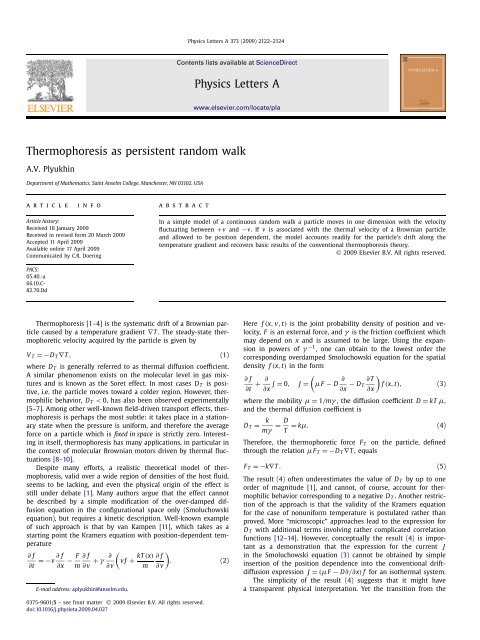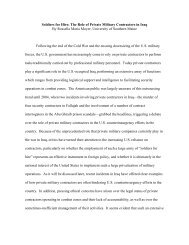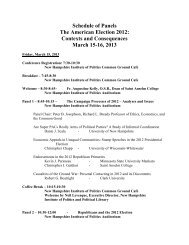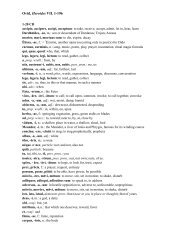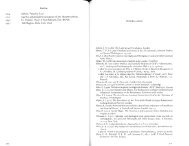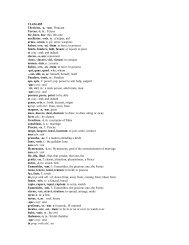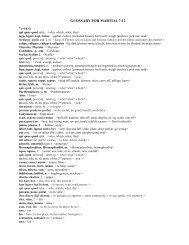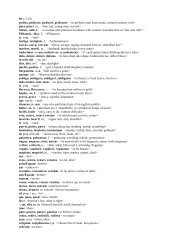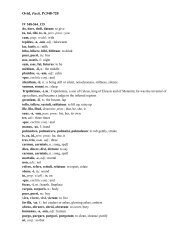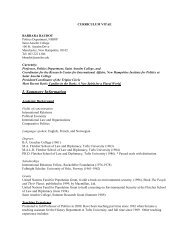Thermophoresis as persistent random walk - Saint Anselm College
Thermophoresis as persistent random walk - Saint Anselm College
Thermophoresis as persistent random walk - Saint Anselm College
You also want an ePaper? Increase the reach of your titles
YUMPU automatically turns print PDFs into web optimized ePapers that Google loves.
Physics Letters A 373 (2009) 2122–2124<br />
Contents lists available at ScienceDirect<br />
Physics Letters A<br />
www.elsevier.com/locate/pla<br />
<strong>Thermophoresis</strong> <strong>as</strong> <strong>persistent</strong> <strong>random</strong> <strong>walk</strong><br />
A.V. Plyukhin<br />
Department of Mathematics, <strong>Saint</strong> <strong>Anselm</strong> <strong>College</strong>, Manchester, NH 03102, USA<br />
article info abstract<br />
Article history:<br />
Received 16 January 2009<br />
Received in revised form 20 March 2009<br />
Accepted 11 April 2009<br />
Availableonline17April2009<br />
Communicated by C.R. Doering<br />
In a simple model of a continuous <strong>random</strong> <strong>walk</strong> a particle moves in one dimension with the velocity<br />
fluctuating between +v and −v. If v is <strong>as</strong>sociated with the thermal velocity of a Brownian particle<br />
and allowed to be position dependent, the model accounts readily for the particle’s drift along the<br />
temperature gradient and recovers b<strong>as</strong>ic results of the conventional thermophoresis theory.<br />
© 2009 Elsevier B.V. All rights reserved.<br />
PACS:<br />
05.40.-a<br />
66.10.C-<br />
82.70.Dd<br />
<strong>Thermophoresis</strong> [1–4] is the systematic drift of a Brownian particle<br />
caused by a temperature gradient ∇T . The steady-state thermophoretic<br />
velocity acquired by the particle is given by<br />
V T =−D T ∇T , (1)<br />
where D T is generally referred to <strong>as</strong> thermal diffusion coefficient.<br />
A similar phenomenon exists on the molecular level in g<strong>as</strong> mixtures<br />
and is known <strong>as</strong> the Soret effect. In most c<strong>as</strong>es D T is positive,<br />
i.e. the particle moves toward a colder region. However, thermophilic<br />
behavior, D T < 0, h<strong>as</strong> also been observed experimentally<br />
[5–7]. Among other well-known field-driven transport effects, thermophoresis<br />
is perhaps the most subtle: it takes place in a stationary<br />
state when the pressure is uniform, and therefore the average<br />
force on a particle which is fixed in space is strictly zero. Interesting<br />
in itself, thermophoresis h<strong>as</strong> many applications, in particular in<br />
the context of molecular Brownian motors driven by thermal fluctuations<br />
[8–10].<br />
Despite many efforts, a realistic theoretical model of thermophoresis,<br />
valid over a wide region of densities of the host fluid,<br />
seems to be lacking, and even the physical origin of the effect is<br />
still under debate [1]. Many authors argue that the effect cannot<br />
be described by a simple modification of the over-damped diffusion<br />
equation in the configurational space only (Smoluchowski<br />
equation), but requires a kinetic description. Well-known example<br />
of such approach is that by van Kampen [11], which takes <strong>as</strong> a<br />
starting point the Kramers equation with position-dependent temperature<br />
∂ f<br />
∂t =−v ∂ f<br />
∂x − F ∂ f<br />
m ∂ v + γ ∂ (<br />
vf + kT(x) )<br />
∂ f<br />
. (2)<br />
∂ v m ∂ v<br />
E-mail address: aplyukhin@anselm.edu.<br />
Here f (x, v, t) is the joint probability density of position and velocity,<br />
F is an external force, and γ is the friction coefficient which<br />
may depend on x and is <strong>as</strong>sumed to be large. Using the expansion<br />
in powers of γ −1 , one can obtain to the lowest order the<br />
corresponding overdamped Smoluchowski equation for the spatial<br />
density f (x, t) in the form<br />
∂ f<br />
∂t + ∂ (<br />
∂x J = 0, J = μF − D ∂ )<br />
∂x − D ∂ T<br />
T f (x, t), (3)<br />
∂x<br />
where the mobility μ = 1/mγ , the diffusion coefficient D = kT μ,<br />
and the thermal diffusion coefficient is<br />
D T =<br />
k<br />
mγ = D = kμ. (4)<br />
T<br />
Therefore, the thermophoretic force F T on the particle, defined<br />
through the relation μF T =−D T ∇T ,equals<br />
F T =−k∇T . (5)<br />
The result (4) often underestimates the value of D T by up to one<br />
order of magnitude [1], and cannot, of course, account for thermophilic<br />
behavior corresponding to a negative D T .Anotherrestriction<br />
of the approach is that the validity of the Kramers equation<br />
for the c<strong>as</strong>e of nonuniform temperature is postulated rather than<br />
proved. More “microscopic” approaches lead to the expression for<br />
D T with additional terms involving rather complicated correlation<br />
functions [12–14]. However, conceptually the result (4) is important<br />
<strong>as</strong> a demonstration that the expression for the current J<br />
in the Smoluchowski equation (3) cannot be obtained by simple<br />
insertion of the position dependence into the conventional driftdiffusion<br />
expression J = (μF − D∂/∂x) f for an isothermal system.<br />
The simplicity of the result (4) suggests that it might have<br />
a transparent physical interpretation. Yet the transition from the<br />
0375-9601/$ – see front matter © 2009 Elsevier B.V. All rights reserved.<br />
doi:10.1016/j.physleta.2009.04.027
A.V. Plyukhin / Physics Letters A 373 (2009) 2122–2124 2123<br />
Kramers equation (2) in ph<strong>as</strong>e space to Eq. (3) for the spatial distribution<br />
function f (x, t) = ∫ dv f (x, v, t) (the elimination of the<br />
f<strong>as</strong>t variable v) isnotatrivialstep[15,16], which makes the origin<br />
of the result (4) somewhat obscure. The same perhaps may<br />
be said of the Luttinger’s method of fictitious external fields [17],<br />
which also leads to the result (4) [18,19]. The aim of this Letter is<br />
to formulate a minimal qualitative model of thermophoresis, which<br />
leads to the expression (4) elementary and directly. Besides pedagogical<br />
merits, such model might be useful for numerical modeling<br />
of stoch<strong>as</strong>tic processes at nonuniform temperature.<br />
The model is a slightly generalized version of the well-known<br />
stoch<strong>as</strong>tic process of the continuous <strong>persistent</strong> <strong>random</strong> <strong>walk</strong><br />
[20–22]. In its simplest setting, the process describes a particle<br />
moving in one dimension with fixed speed v suffering occ<strong>as</strong>ionally<br />
a complete reversal of direction. Let f + (x, t) and f − (x, t) be<br />
the probability density for the particle moving to the right and to<br />
the left, respectively. Reversals of velocity are Poisson distributed,<br />
i.e. occurring with a constant rate 1/2τ , so that the probability for<br />
reversal in a time interval dt is dt/2τ . For an infinitesimal time<br />
step one can write<br />
f + (x, t + dt) = f + (x − vdt, t) − f + (x − vdt, t) dt/2τ<br />
+ f − (x + vdt, t) dt/2τ , (6)<br />
and a similar equation for f − (x, t). The corresponding differential<br />
equations read<br />
∂ f +<br />
∂t<br />
=−v ∂ f +<br />
∂x<br />
− f + − f −<br />
,<br />
2τ<br />
∂ f −<br />
∂t<br />
= v ∂ f −<br />
∂x<br />
+ f + − f −<br />
, (7)<br />
2τ<br />
and lead to the telegrapher’s equation for the total density f =<br />
f + + f − ,<br />
∂ 2 f<br />
∂t + 1 2 τ<br />
∂ f<br />
∂t = v2 ∂2 f<br />
∂x 2 . (8)<br />
The same equation holds also for the difference Δ = f + − f − , and<br />
therefore for the components f + and f − separately.<br />
Suppose the particle at t = 0 is at the origin with equal probability<br />
to be in each of the two velocity states,<br />
f ± (x, 0) = 1 2 δ(x), ∂ f ± (x, 0)<br />
=∓ v ∂<br />
δ(x). (9)<br />
∂t 2 ∂x<br />
Here the second initial condition follows from the first one and<br />
Eq. (7). Respectively, the initial conditions for the total density f =<br />
f + + f − are<br />
∂ f (x, 0)<br />
f (x, 0) = δ(x), = 0. (10)<br />
∂t<br />
The corresponding solution of the telegrapher’s equation is well<br />
known [26]. In the long-time limit t ≫ τ , vt ≫ x it coincides exactly<br />
with solution of the Smoluchowski equation<br />
)<br />
f (x, t) ≈ (4π Dt) −1/2 exp<br />
(− x2<br />
(11)<br />
4Dt<br />
with the diffusion coefficient D = τ v 2 . However, unlike the overdamped<br />
Smoluchowski equation (3), Eq.(7) incorporates effects of<br />
inertia of the particle. This advantage, which w<strong>as</strong> recognized and<br />
used beneficially in many previous works (see [22] and references<br />
therein), allows to account for thermophoresis in a particularly<br />
simple way.<br />
To link the model to the problem of thermophoresis, it is natural<br />
to identify v with a typical thermal speed of a Brownian<br />
particle. The choice is ambiguous. For instance, one can set v equal<br />
to the root mean square velocity v rms =〈v 2 〉 1/2 = √ 3kT/m. However,<br />
one can show that in this c<strong>as</strong>e the final result for the thermophoretic<br />
force would differ from Eq. (5) by the factor 3/2 (see<br />
Eq. (16) below). As will be shown, a perfect agreement with the<br />
standard results D T = D/T and F T =−k∇T can be achieved if v<br />
is identified not with v rms but with the most probable speed of a<br />
Brownian particle v mp (for which the Maxwell speed distribution<br />
h<strong>as</strong> a maximum):<br />
v = v mp = √ 2kT/m. (12)<br />
The second parameter of the model 1/τ should be identified with<br />
the friction coefficient γ which appears in the Kramers equation<br />
(2) and in the corresponding Langevin equation ˙v =−γ v + ξ(t).<br />
For nonuniform temperature, the velocity in Eq. (7) is position<br />
dependent, v(x) = √ 2kT(x)/m. In this c<strong>as</strong>e instead of the telegrapher’s<br />
equation (8) one obtains [23]<br />
∂ 2 f<br />
∂t + 1 (<br />
∂ f<br />
2 τ ∂t = ∂2 f<br />
v2 ∂x + 2 v dv ) ∂ f<br />
dx ∂x . (13)<br />
Suppose the temperature gradient is constant, so that T (x) = T +<br />
x ∇T and<br />
v(x) = √ (<br />
2kT(x)/m = v<br />
1 + ∇T<br />
T x ) 1/2<br />
, (14)<br />
where v is the thermal velocity corresponding to the temperature<br />
T , v = √ 2kT/m. ThenEq.(13) reads <strong>as</strong><br />
∂ 2 f<br />
∂t + 1 2 τ<br />
(<br />
∂ f<br />
∂t = v2 1 + ∇T<br />
T<br />
) ∂ 2 x f ∇T<br />
+ v2<br />
∂x2 2T<br />
∂ f<br />
∂x .<br />
For a small gradient (∇T /T )x ≪ 1, the equation is simplified to<br />
the form<br />
∂ 2 f<br />
∂t + 1 ∂ f<br />
2 τ ∂t = ∂2 f<br />
v2 ∂x − F T ∂ f<br />
2 m ∂x , (15)<br />
where the thermophoretic force F T coincides (thanks to the setting<br />
v = √ 2kT/m) with the expression (5) of the standard theory:<br />
F T =− 1 ∇T<br />
mv2 =−k∇T . (16)<br />
2 T<br />
It can be shown that in the long-time limit the solution of Eq. (15)<br />
with the boundary conditions (10) coincides with the solution of<br />
the overdamped equation (3) and describes the drift along the<br />
temperature gradient, superimposed on the diffusion<br />
f (x, t) ≈<br />
1<br />
√ 4π Dt<br />
exp<br />
(− (x − V T t) 2 )<br />
4Dt<br />
(17)<br />
with the drift velocity V T = F T τ /m. Using(16) and recalling D =<br />
τ v 2 ,onegetsV T =−D T ∇T with D T = D/T , thus recovering the<br />
result (4) of the conventional theory.<br />
The <strong>as</strong>ymptotic solution (17) can be obtained <strong>as</strong> follows. After<br />
applying the transformation f (x, t) = φ(x, t) exp(−t/2τ +<br />
F T x/2mv 2 ),Eq.(15) takes the form<br />
∂ 2 φ<br />
∂t 2<br />
= ∂2 φ<br />
v2 ∂x + 1 φ, 2 τ∗<br />
2 (18)<br />
with 1/τ 2 ∗ = 1/4τ 2 − F T /4m 2 v 2 , while the boundary conditions<br />
corresponding to (10) read<br />
φ(x, 0) = δ(x),<br />
∂φ(x, 0)<br />
∂t<br />
= 1<br />
2τ δ(x).<br />
Note that the model makes sense only under the <strong>as</strong>sumption τ∗ 2 ><br />
0, which guarantees the positiveness of f + and f − [25]. Eq.(18) is<br />
the modified telegrapher’s equation whose solution is well known<br />
[26]. Transforming back from φ to f ,theresultcanbewrittenin<br />
the following form<br />
(<br />
f (x, t) = exp<br />
− t<br />
2τ +<br />
F T x<br />
2mv 2 )<br />
(φ 1 + φ 2 + φ 3 ), (19)
2124 A.V. Plyukhin / Physics Letters A 373 (2009) 2122–2124<br />
where the functions φ i (x, t) are<br />
φ 1 (x, t) = 1 [ ]<br />
δ(x − vt) + δ(x + vt) ,<br />
2<br />
φ 2 (x, t) = 1 ( 1 √ )<br />
4vτ I 0 v<br />
vτ 2 t 2 − x 2 θ ( vt −|x| ) ,<br />
∗<br />
φ 3 (x, t) =<br />
t<br />
2τ ∗<br />
√<br />
v 2 t 2 − x 2 I 1<br />
( 1<br />
vτ ∗<br />
√<br />
v 2 t 2 − x 2 )<br />
θ ( vt −|x| ) , (20)<br />
and θ(x) is the unit step function. Using the <strong>as</strong>ymptotic form of<br />
the modified Bessel functions for large argument I α (x) ≈ 1 √ 2π x<br />
e x ,<br />
it is an e<strong>as</strong>y matter to prove that in the limit of strong damping<br />
F T τ /mv ≪ 1 and of long time t ≫ τ , vt ≫ x, the exact solution<br />
(19) is reduced to the simple form (17).<br />
One interesting problem related to thermophoresis is that of<br />
Brownian motors driven by position-dependent temperature. In<br />
particular, the Büttiker–Landauer [27,28] motor is essentially a<br />
Brownian particle diffusing in the periodic potential field subject<br />
to a spatially inhomogeneous temperature. In this context it is of<br />
interest to generalize the model to the c<strong>as</strong>e of the presence of<br />
an external force F . As discussed in [25], in this c<strong>as</strong>e Eq. (7) for<br />
f ± (x, t) should be extended <strong>as</strong> follows<br />
∂ f ±<br />
∂t<br />
∂ 2 f<br />
∂t + 1 2 τ<br />
=∓v ∂ f ±<br />
∂x<br />
∓ f + − f −<br />
2τ<br />
∂ f<br />
∂t = ∂2 f<br />
v2 ∂x − F T ∂ f<br />
2 m ∂x − ∂ ∂x<br />
± F<br />
2mv ( f + + f − ). (21)<br />
Respectively, Eq. (15) for the total density f = f + + f − is generalized<br />
to the form<br />
( ) F<br />
m f . (22)<br />
This equation differs from the overdamped equation (3) of the<br />
standard theory by the presence of the term f tt . This term, related<br />
to inertial effects, is unimportant in the long time limit, but<br />
may be responsible for wave-like behavior at short times [22].<br />
Summarizing, in this Letter we discussed a stoch<strong>as</strong>tic process<br />
which underlies thermophoresis in a way similar to that <strong>as</strong> the discrete<br />
<strong>random</strong> <strong>walk</strong> underlies isothermal diffusion. The model leads<br />
to the telegrapher’s equation whose <strong>as</strong>ymptotic solution coincides<br />
with the solution of the overdamped Smoluchowski equation (3).<br />
This is consistent with an observation that the telegrapher’s equation<br />
is reduced to the Smoluchowski equation under conditions<br />
v →∞, τ → 0, v 2 τ = const. Since the model takes into account<br />
inertial effects, one might hope that it can resolve difficulties of the<br />
overdamped theory of thermally driven Brownian motors [8–10].<br />
However, similar to the Kramers equation (2), the model is b<strong>as</strong>ed<br />
on the <strong>as</strong>sumption that the thermalization of the particle to a local<br />
temperature is f<strong>as</strong>ter than any other process involved. Since the<br />
characteristic time scales for inertial and thermalization effects are<br />
typically the same, the application of the model beyond the overdamped<br />
regime, strictly speaking, is not justified, and should be<br />
undertaken with caution. Despite of this limitation, the mapping<br />
of thermophoresis onto a <strong>random</strong> <strong>walk</strong> problem may offer some<br />
advantage for both analytical and numerical modeling, in particular<br />
for problems with complicated or velocity-dependent [24,25]<br />
boundary conditions.<br />
Acknowledgements<br />
I thank Richard Bowles, Stephen Shea, and the referees for stimulating<br />
comments.<br />
References<br />
[1] R. Piazza, A. Parola, J. Phys.: Cond. Matter 20 (2008) 153102.<br />
[2] M. Braibanti, D. Vigolo, R. Piazza, Phys. Rev. Lett 100 (2008) 108303.<br />
[3] S. Duhr, D. Braun, Phys. Rev. Lett. 96 (2006) 168301.<br />
[4] E. Bringuier, A. Bourdon, Phys. Rev. E 67 (2003) 011404;<br />
E. Bringuier, A. Bourdon, Physica A 385 (2007) 9.<br />
[5] M. Giglio, A. Vendramini, Phys. Rev. Lett. 38 (1977) 26.<br />
[6] B.-J. de Gans, R. Kita, B. Müller, S. Wiegand, J. Chem. Phys. 118 (2003) 8073.<br />
[7] S. Iacopini, R. Piazza, Europhys. Lett. 63 (2003) 247.<br />
[8] I. Derényi, R.D. Astumian, Phys. Rev. E 59 (1999) R6219.<br />
[9] T. Hondou, K. Sekimoto, Phys. Rev. E 62 (2000) 6021.<br />
[10] R. Benjamin, R. Kawai, Phys. Rev. E 77 (2008) 051132.<br />
[11] N.G. van Kampen, IBM J. Res. Develop. 32 (1988) 107;<br />
N.G. van Kampen, J. Phys. Chem. Solids 49 (1988) 673.<br />
[12] G. Nicolis, J. Chem. Phys. 43 (1965) 1110.<br />
[13] D.N. Zubarev, A.G. B<strong>as</strong>hkirov, Physica 39 (1968) 334.<br />
[14] J.-E. Shea, I. Oppenheim, J. Phys. Chem. 100 (1996) 19035.<br />
[15] M.E. Widder, U.M. Titulaer, Physica A 154 (1989) 452.<br />
[16] J.M. Sancho, M. San Miguel, D. Dürr, J. Stat. Phys. 28 (1982) 291.<br />
[17] J.M. Luttinger, Phys. Rev. 135 (1964) A1505.<br />
[18] A.L. Efros, Sov. Phys. JETP 23 (1966) 536.<br />
[19] A.G. B<strong>as</strong>hkirov, Theor. Math. Phys. 1 (1969) 213.<br />
[20] S. Goldstein, Quart. J. Mech. Appl. Math. 4 (1951) 129.<br />
[21] M. Kac, Rocky Mountain J. Math. 4 (1974) 497.<br />
[22] G.H. Weiss, Physica A 311 (2002) 381.<br />
[23] J. M<strong>as</strong>oliver, G.H. Weiss, Phys. Rev. E 49 (1994) 3852.<br />
[24] J. M<strong>as</strong>oliver, J.M. Porra, G.H. Weiss, Phys. Rev. E 45 (1992) 2222.<br />
[25] A.V. Plyukhin, K.S. Kim, Phys. Rev. E 61 (2000) 3207.<br />
[26] E. Zauderer, Partial Differential Equations of Applied Mathematics, Wiley, New<br />
York, 1983.<br />
[27] M. Büttiker, Z. Phys. B 68 (1987) 161.<br />
[28] R. Landauer, J. Stat. Phys. 53 (1988) 233.


